Looking at the list, I found myself wanting to tailor my chosen three to explore towards my works emerging themes. I chose:
- Extreme Size
- Extreme detail (with an emotional undertone)
- Extreme material (with a basis for using)
Size
Using the developed thematic findings from these two boards, I isolated ways I could extend the ideas into extremes.

Looking at dolls or character / sculptures (left hand board) – having made links to myself and family personally, I wanted to add depth to this. Thus a “life size” cut out, using my body for shape. This could be seen as a mock up of a future piece, a chance to see if the idea would work if tried.
Imagery above documents the cut out process, using my body as a mould.
Using the process of scaling down, I made a cut out of the large “me” cut out around the side of 9″. Thus a very obvious difference seen.
Using the idea of facial detail from my other board, I began experimenting with laser cutting.
 Using imagery from the Maison Margiela SS17 collection, the idea of scaling my faces large or tiny was planted into my head. Could the designs become the size of a full outfit? Or could they be made tiny to be an adornment on a garment?
Using imagery from the Maison Margiela SS17 collection, the idea of scaling my faces large or tiny was planted into my head. Could the designs become the size of a full outfit? Or could they be made tiny to be an adornment on a garment?
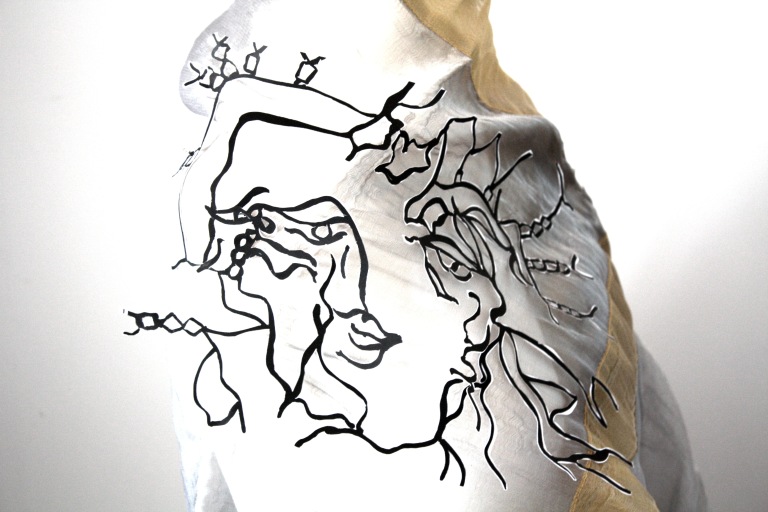
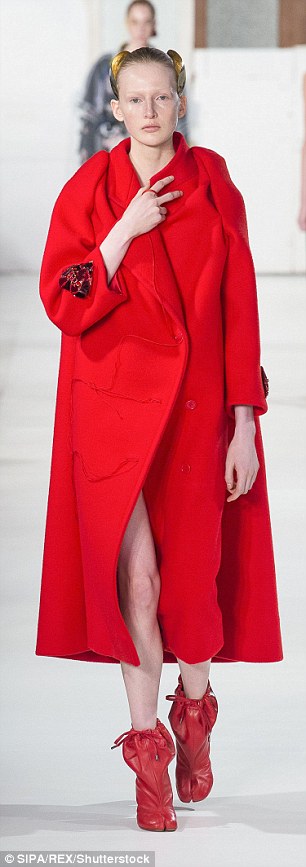
Using the model of my small scaled down sculpture, I scaled down the original designs I had and printed them onto a silk voile. Presenting them in this way for photo purposes.
Could a design this small have the same impact as the ‘hearts on sleeve’ garment?
Future?
I question why I have chosen this as an extreme. I worried that if I did not try a variety of scales, I may be inclined to stick to one size, i.e. a doll size etc. By using mock ups in paper form, I am able to predict and visualise what an outcome may look like in another material too. The concept of the paper mock up, is handy due to time constraints.
The facial trials are interesting, as I am using the bed of my own designs. I like the idea that they are being reused, almost resurrected from a dormant place. They were a part of the body of work which I got a low mark for at assessment, thus it feels like Kintsugi when I am using them for a new, fresh purpose.
Will I extend this further?
Scale is something I will keep in mind for Part Three. Looking at pushing what the meaning of scale is, could be a path I try.
Detail (with emotion links)
Using the sensitive meanings behind my work, I began to ascertain how little or detailed a piece would have to be in order to convey emotion. Can it be said without words? Can it be presented with little expression or hints?
Can emotion be conveyed in the stance or body of a sculptural form? Does it need to be written?
Sometimes it is the meaning behind a piece:
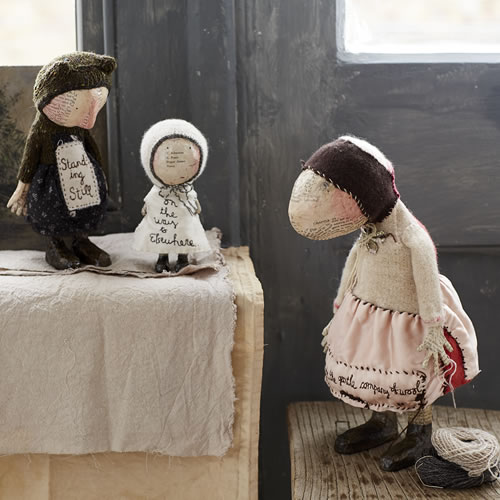
I want to illustrate the difference in detail and blank form; as I perceive this being a strong area of interest for myself. First, detail…..
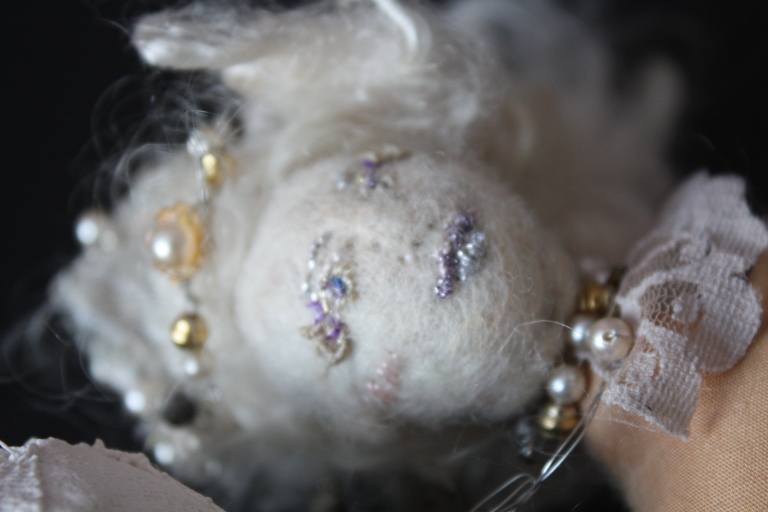
One of my felt ball structures created through 2.1 Pre Visual collection. I used silk embroidery to draw a face and add lots of detail. This could be pushed further emotionally or in another way – i.e. a face could be drawn crying etc. Thus obvious expression.
What about less?
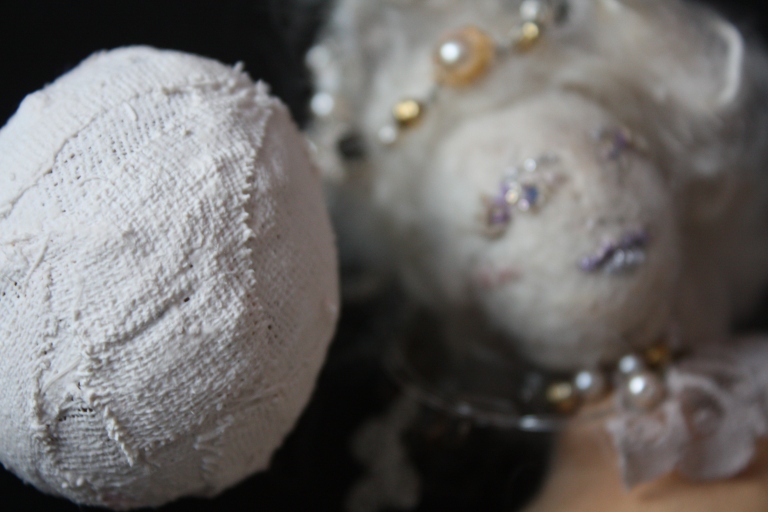
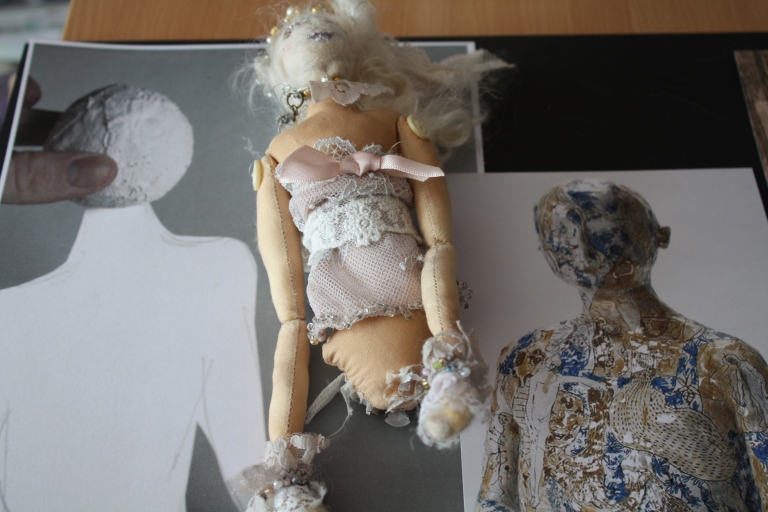
One of my covered eggs, broken and “healed with Jesmonite and literal bandage. Thus it is the materials which tell the story, the emotion or meaning, not needing written or embroidered detail.
This is just one example of the polar extremes within this detail theme. However I would love to push this further later in my project – how can the core material or technique process convey the same power of meaning, as the written word or a literal depiction of a narrative?
Extreme material choice (could this convey a feeling or stance?)
As said, I want to isolate the idea of conveying a narrative or emotion through the material choice. This links with my comments surrounding extreme detail. For this experiment, I compared fabrics……look at the black leather which I have embedded studs within. Compare this to the white “innocent” fluffy fabric, along with white felt and a prim crocheted floral adornment. Would could they all “say”? Could an impression be given through say the leather/studs? An aura of “don’t touch me?”

Looking at artists who work with somewhat unconventional materials – take Hannalie Lette who uses rubber as her “fabric” to embroider. Or Lucy Simpson who creates products from silicone.
Could I look towards using materials which may seem unconventional or are less used for sculpture or indeed when using my portraits as based material for samples? Could the material relate back to the theme I am working on?
Taking a note of such points will help to widen my options.
There are many ways I could push my themes, thus this is something I will reflect back on even in Part Three, as I feel it is healthy to keep pushing my developments in this manner and it helps me perceive what is possible; making me take risks.
Peer Feedback
I got a few individuals who know me to look at the extremes I had chosen and give me some thoughts.
The main one which stuck to me, was the need to be individual in my choices. Out of the three, the main favourite was the one where I looked at conveying emotion through detail or less detail. Why? Because this one was said to be the one most tailored to me, rather than fulfilling a requirement. This taught me a lesson – maybe I could be pushing further with the extreme themes chosen in the future, in order to make my work unique. I could look at creating my own genre’s of what extreme could mean to me – as its a field which could change from person to person and cannot in itself be quantified.
Own thoughts?
On reflection, I feel that having the extremes as a starting point really made me think about what the possibilities are, as its easy to keep pushing ones own ideas without thinking about the less obvious.
I feel that the size extreme is the weakest with its meaning to myself, yet it has helped me think about what I could do in this way – i.e. could I or would I want to create a soft sculpture the size of a human? Why would I? On the other hand, what meaning could be behind it? I.E. Could a small doll, photographed in a certain way, emulate emotion – for example if in a pocket – lack of security, or the need for?

Example of a pocket doll above, this is reminiscent of the worry doll too, as discussed in this post.
Through Part Three of this course, it is my intention to question the use of extremes or the elements which have come out of them – creating links between the underpinning meaning of my work and the way I portray it.
I note that photography and staging can create a definite mood or say something – this is an element I would like to develop.
What other extremes could I have used or try as I progress?
- Beauty came to the fore – yet I questioned if this could be quantified. Beauty is in the eye of the beholder – who am I to judge that?
- Audience – what could an extreme audience be? Again hard to quantify and depends on the material involved or risks taken. For example a “risk” could be asking a well known shop to allow me to hire a window for timed display. yet would this be extreme?
- Movement interested me, especially in relation to the areas of interest I am perusing. For example, could I create a garment in jesmonite, essentially this would be like wearing concrete. What would happen? Could the wearer move? Or what about creating a sculpture with complete moveable parts? Construction as an extreme is a similar one- thus could fit in. This could also take in scale.
I investigated one artist who has had a similar thought:
Phoebe Corker Marin
She researched joint movement within her own body and linked this to sculptural forms, using plastic discs all linked together to create a leg joint.
I would love to interview her to find out more about her work – email? A visit?
Final outcomes for this section
A board documenting the three extremes chosen has been created to illustrate:

Close up shots of the board for observation:
References
Corker-Marin, P. (2018). Venus Figures. [online] Phoebecorkermarin.com. Available at: http://phoebecorkermarin.com/figureprojects.html [Accessed 4 May 2018].
Green stage gallery(2018). Pierre Williams – Artist Profile. [online] Available at: https://www.greenstagegallery.co.uk/artist/91/pierre-williams [Accessed 4 May 2018].
Maison margiela (2018). Artisanal – SS17 Show | Maison Margiela. [online] Available at: https://www.maisonmargiela.com/gb/collections/artisanal-ss17-show [Accessed 4 May 2018].
Royal College of Art. (2018). Show 2018. [online] Available at: https://www.rca.ac.uk/news-and-events/events/show-2018/ [Accessed 4 May 2018].
Vogue. (2018). Maison Margiela Spring 2017 Ready-to-Wear Fashion Show. [online] Available at: https://www.vogue.com/fashion-shows/spring-2017-ready-to-wear/maison-martin-margiela [Accessed 4 May 2018].
Williams, P. and Williams, P. (2018). Pierre Williams – Artists. [online] Affordableartfair.com. Available at: https://affordableartfair.com/artists/pierre-williams [Accessed 4 May 2018].
















